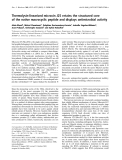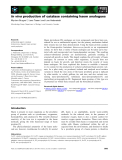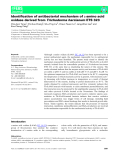
Antibacterial mechanism
-
: In recent decades, the antimicrobial surfaces/coating properties towards a longlasting microbicidal effect have drawn enormous attention by researchers, they have been developed and used in a wide variety of high-touch hospital devices as a potential approach.
 9p
9p  larachdumlanat127
larachdumlanat127
 02-01-2021
02-01-2021
 11
11
 3
3
 Download
Download
-
Microcin J25 (MccJ25) is the single macrocyclic antimicro-bial peptidebelonging to the ribosomally synthesizedclass of microcins that are secreted byEnterobacteriaceae.Itshowed potent antibacterial activity against severalSalmonellaand Escherichiastrains and exhibited a compact three-dimen-sional structure [Blondet al. (2001) Eur. J. Biochem., 268, 2124–2133]. The molecular mechanisms involved in the biosynthesis, folding andmode of action of MccJ25 are still unknown.
 11p
11p  tumor12
tumor12
 22-04-2013
22-04-2013
 44
44
 2
2
 Download
Download
-
Haem (protohaem IX) analogues are toxic compounds and have been con-sidered for use as antibacterial agents, but the primary mechanism behind their toxicity has not been demonstrated. Using the haem protein catalase in the Gram-positive bacterium Enterococcus faecalisas an experimental system, we show that a variety of haem analogues can be taken up by bac-terial cells and incorporated into haem-dependent enzymes.
 10p
10p  mobifone23
mobifone23
 21-01-2013
21-01-2013
 56
56
 4
4
 Download
Download
-
AlthoughL-amino oxidase (LAAO; EC 1.4.3.2) has been reported to be a potent antibacterial agent, the mechanism responsible for its antibacterial activity has not been identified. The present study aimed to identify the mechanism responsible for the antibacterial activity of Th-LAAO, an LAAO recently isolated from the extracellular proteins of Trichoderma harzianum ETS 323, at the same time as elucidating the nature of this enzyme.
 14p
14p  cosis54
cosis54
 09-12-2012
09-12-2012
 42
42
 4
4
 Download
Download
-
Adverse Reactions Adverse drug reactions are frequently classified by mechanism as either dose-related ("toxic") or unpredictable. Unpredictable reactions are either idiosyncratic or allergic. Dose-related reactions include aminoglycoside-induced nephrotoxicity, linezolid-induced thrombocytopenia, penicillin-induced seizures, and vancomycin-induced anaphylactoid reactions. Many of these reactions can be avoided by reducing dosage in patients with impaired renal function, limiting the duration of therapy, or reducing the rate of administration.
 9p
9p  colgate_colgate
colgate_colgate
 21-12-2010
21-12-2010
 62
62
 4
4
 Download
Download
CHỦ ĐỀ BẠN MUỐN TÌM

















